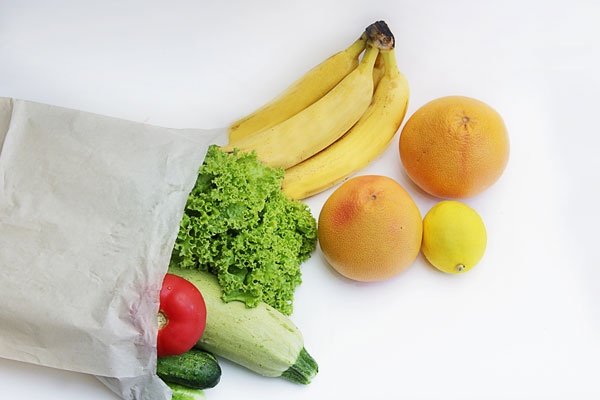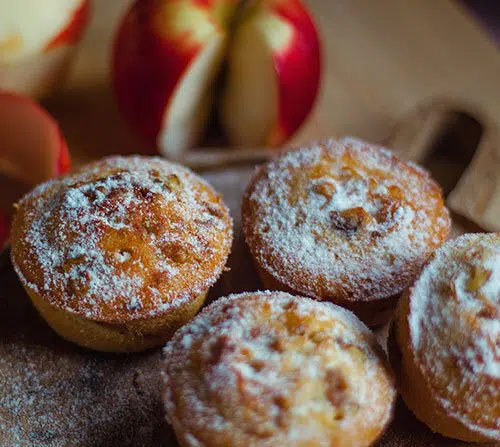Do you face the daily battle of trying to get some healthy fruit and veg into the kids? Kids are known to be fussy, and their tastes can change from one day to the next. If you need some fun ways to encourage your kids to try some healthy foods, then you’ve come to the right place. Here’s 12 fun food games that promote healthy eating in kids.
Looking for new ways to keep the kids try new foods? Why not teach them about healthy eating in the process with these 12 fun food games that promote healthy eating for kids. Who knows, you might come out with a veggie lover on your hands! (We can only dream…)
Fun Food Games that promote healthy eating for kids
1. The fruit and veg guessing bag

This game helps children to learn about a variety of different fruits and vegetables. Simply place a variety of fruit and veg inside a bag. Any bag will do, as long as kids can’t see through to what’s inside. Ask kids to feel inside the bag and guess what they are. You can get them to pick each one up individually, and prompt them with questions to help them guess:
- Is it long or short?
- Is it fat or skinny?
- Is it smooth?
If they are still having trouble guessing, give them hints about what you normally cook it in, or what colour it is. You can also ditch the bag altogether and get the kids to close their eyes and hold out their hands. Place a fruit or vegetable in their hands and ask them to guess what it is by feeling, smelling or even tasting it. Exploring food with all of their senses moves them closer to trusting and eating that food (…one day!). Turn it into a game by giving out points for every item they get correct!
2. The odd one out quiz
This is a quick “brain game” that can be played anywhere. Let your child know that you are going to give them four words and they have to pick the odd one out. Include three fruits or three vegetables and one word that doesn’t fit (that isn’t a fruit or vegetable). For example, you could say: potato, capsicum, dog and pumpkin. Ask your child to pick the odd one out…’dog’. Another example, you could say: strawberries, brush, grapes and watermelon. The odd one out being the ‘brush’.
You can make the game a little harder by asking them to tell you what the theme of the three others words is, like fruits or vegetables. You can make it really difficult (for other adults) by extending this to nuts and legumes. You can even get the kids involved and see if they can come up with three fruits and vegetables and give you an odd one out!
3. Make your own plant person
It’s time to get creative in the kitchen! Create a ‘plant person’ using real fruit and vegetables.
If you want to extend the activity, then get creative and bring out the toothpicks. Challenge the kids to see if they can make a standing plant person. Once you’re done, it’s a great chance to ask the kids if they want to eat some of their plant person for morning or afternoon tea.
4. Get crafty with a food
Bring out those old magazines or newspapers, or failing that, pick up a copy of the Coles or Woolworths free magazines next time you do a shop. Set the kids up with some scissors and let them have fun cutting out pictures of food. It’s a great fine motor activity at the same time. For younger children, get them to match these to a letter and then draw their own version of the food. For the older kids, have them stick pictures on a sheet from top to bottom and plan out a daily menu: breakfast, morning tea, lunch, afternoon tea, dinner.
You can challenge them further and ask them to create a recipe in their head and then find pictures of food ingredients that they could use to make that recipe. For example, they might choose spaghetti bolognese and find pictures of pasta, tomato, onion, meat and herbs. These simple activities are the perfect way to introduce healthy eating to kids.
5. Drum roll… Food letter of the day is ‘C’
Each week choose a letter from the alphabet and taste and discuss plant foods which start with that letter. For example, for the letter ‘C’ try carrot, cauliflower, corn, cucumber, capsicum. Send the younger kids to the fridge and fruit bowl, and see if they can find any fruits or vegetables you have at home that start with that letter. You can them start planning a meal with some of those vegetables in it that kids can help out with and taste.
For the older kids, you can play a quick version of scattergories and have everyone in the family having write down as many foods starting with that letter that they can think of!
6. Get baking or cooking

Apple and Cinnamon Muffins
Baking and cooking is always a great opportunity to get kids involved in the kitchen. Don’t stress too much if they want to start with a slightly more ‘sugary’ recipe – at least it gets them involved and off and running in the kitchen.
Substitute with wholemeal flour wherever possible – you can buy both self-raising or plain wholemeal flour. They both still contain wheat, so the texture won’t be affected and the recipe will still turn out well, it’s just healthier!
Baking is a fun way to incorporate basic maths – measuring out the ingredients. Making pasta or gnocchi is another fun option – but be prepared for mess!! ?
Find some of my tasty nutrient packed recipes here.
7. Make funny faces out of food

My daughter loved doing this last year at school. She came home so excited about trying raw onion and loving it (yuk!). The students grated carrot, zucchini, onion (and probably other veggies) together with chopping capsicum and cauliflower. They also used sultanas for eyes.
They had a great time making faces on a plate. There was absolutely no pressure to eat the veggies, just have fun. This is a great way to increase children’s sensory experiences (and then probably acceptance) with veggies in fun and entertaining environment. Perfect for promoting healthy eating in kids.
Use whatever you have at home and give it a go! You can even chop up fruit and give that a go as well.
8. Pop the blindfold on

This is a great way to get your child to try new foods in a fun environment, but they have to be up for it. If they aren’t sure, get a parent or older child to go first to show how it’s done, and they might be more willing after seeing the game in action. I’m sure they will love creating a blindfold plate for you!
Grab a blindfold (or tea towel tied behind the head), a plate and eight small pieces of food and give it a go! Get them to taste each food and guess what it is before moving onto the next. For the first round, include eight foods that they know, like and trust.
For the second round, include five foods that they know like trust and three foods that you would like them to try, or that they haven’t had huge exposure to.
9. Head out into the garden

There’s a reason why you feel good outside in the garden. Being amongst mother nature benefits both our physical and mental wellbeing. Nature play has clear physical benefits for developing children and positively impacts their mental and social wellbeing. Gardening is a fantastic opportunity to connect with nature. Science supports us getting our hands dirty and research shows that it can support a healthy immune system. A Finnish study showed that children who spend time in forest dirt had better immune system regulation.
Gardening is a great opportunity to discuss where food comes from and how it grows. If you have the space, why not set up a mini vegetable garden with the kids. Some easy to grow, edible produce includes tomatoes, peas, beans, snow peas and herbs. Kids will love helping you plant them and watching them grow over time. Plus, they will be much more interested eating food they have grown themselves. If you don’t have the space, you can just set up a few small plants and stick with the herbs. The challenge will be – who will water them?
You could also take the fruit picking one weekend! We’ve got lots of local orchards and fruit farms featured by season here.
10. Guess the food
Take turns in a guessing game of food. For example: “I am thinking of a food starting with the letter C which is orange and hard… and you can eat it both raw and cooked”. Give extra clues like colour, shape, texture, and so on, until children correctly guess the food. Let children take turns to choose and describe a food.
You can even turn this into a game of 20 questions. Pick a fruit, and get the kids to ask questions to see if they can guess the fruit you are thinking of. This is a great one for the older kids, and you can even play it in the car to break up a road trip. It’s a great way to have fun while promoting healthy eating in kids.
11. Try the salty potato experiment
This experiment teaches children a little about salt and how we should limit our intake. Start by filling two small bowls with water and mix salt into one of the bowls. Using a sticker or a marker, label the bowls so you know which one has the salty water and which one is plain.
Take a regular potato and cut it in half. Place one half in each bowl with the flat side (cut side) facing down. Leave the potato’s in the bowls for approximately 30 mins and watch what happens.
You will find that the salty water draws the water out of the potato, causing it to shrivel. The learning here is that just like the potato loses water when put in a salty solution, we too get thirsty and need extra water when eat too much salty food. We need to try to limit our intake of salty foods.
12. Make up a funny song about food
Have a competition between family members to come up with a funny song about a food. For example, “Mr Broccoli from the Bungle Bungles who loves to do the high jump”. They an use a familiar song (maybe even their favourite song) and just change the words!
I hope some of these activities brings a smile to your faces. Family food should be fun!












